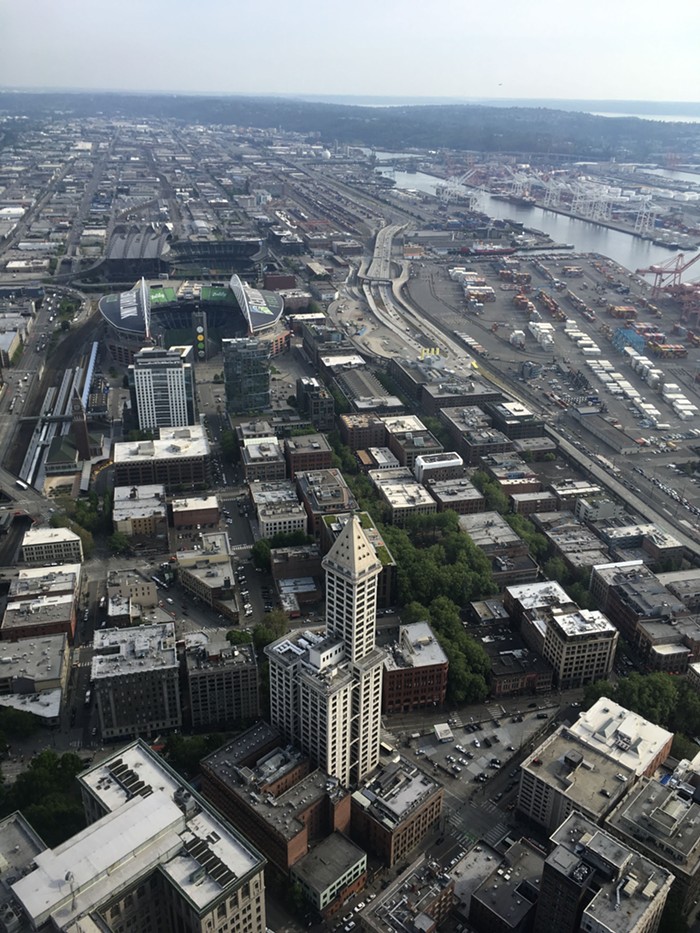
With Pride season upon us and businesses cautiously re-opening, now might be a nice time to spend some time in Seattle’s traditional gayborhood: The mudflats below the Deadline. Wait, where?
Long before Capitol Hill became the home of rainbow crosswalks, and before Renton Hill was briefly Seattle’s gay destination in the 1970s, Pioneer Square (as the mudflats are now known) was where all the seedy, secret, same-sex action happened. Seattle went through waves of moral freedom and moral panic, but for most of the city’s post-colonizer history, gay life was centered around Second Avenue and S. Washington Street.
Today, there’s barely any indication that the neighborhood was ever queer. But the hints remain, if you know where to look: On the side of a loan shop, you can see an awning with the words “CASINO DANCING” that’s been there for about a hundred years. That marks the former site of The People’s Theater, a disreputable box house — basically a theater/brothel combo — where anything went.
In the late 1800s, that part of Seattle was only barely developed. Ramshackle hotels, saloons, and rickety shacks lined up along the waterfront—a frontier town giddy with vice. As the neighborhood was known alternately as “Skid Row” or “Fairville,” you could pop into establishments like Madame Lou’s brothel or the Canal Saloon and enjoy a little cruising.
Sodomy legislation and a moral revival led to the shutdown of The People’s Theater in the early 1900s, but it was eventually replaced by The Casino, which for a time was the only place in town where same-sex couples could dance together. Also known as "Madame Peabody's Dancing Academy for Young Ladies," for decades it was Seattle’s premiere queer nightlife spot.
Next door was the upstairs gay bar The Double Header — which state liquor inspectors, who had to approve all bar names, were too dense to realize was a sexual euphemism. Opened in 1934, it would become the longest-operating gay bar in Seattle until it closed in 2015. These days, the building is home to the straight bar Stage Seattle.
Other queer watering holes proliferated nearby through the 1900s. There was The Spinning Wheel at Second and Union, which featured drag queens who sang live — this was in the days before pre-recorded music and lip syncs. Today, it’s a parking garage, like many of the neighborhood’s queer destinations. The Atlas Steam Bath and the Stage Door Tavern at Occidental Ave and South Washington Street were once vibrant meeting places, and are now just a place to leave your car.
In general, highrises and parking lots have replaced all of Pioneer Square’s gay haunts. The Garden of Allah, once a destination for queer soldiers returning from World War II, is now a women’s clothing store at the base of a giant office building. The Mocambo, where Seattle’s Imperial Court was founded, is long gone, replaced by an entrance to the subway station. The Golden Horseshoe, a drag bar where anyone could get up and perform, is now an art gallery.
Just a bit further north was The Madison Tavern, not to be confused with today’s Madison Pub. In its day, the Madison Tavern featured dancing and drinks, and there’s not even the slightest hint of it there today aside from the hole-in-the-wall Mel’s Market at the corner of a massive dark skyscraper.
One of the most famous of the neighborhood’s gay bars was Shelly’s Leg, though it was only open for a few years in the 1970s. Shelly Bauman was a drifter staying with some gay friends when she attended a Bastille Day parade in Pioneer Square; a faulty canon blew a solid wad of confetti into the crowd, hitting her and requiring the amputation of her leg. With the settlement money, she opened the bar and named it for her lost appendage. It was Seattle’s first real disco, and it had a giant sign out front reading “Shelly’s Leg is a GAY BAR provided for Seattle’s gay community and their guests.”
A few years after opening, a tanker truck full of gasoline crashed into the viaduct and a fireball erupted in front of the building. They tried to rebuild, but it was never the same and soon closed.
Throughout this whole history, one of the only constants was antagonism from the Seattle Police Department. When cops weren’t harassing patrons and bar owners — and occasionally trying to kill them — they took steep bribes.
At one point in the 1960s, the police even conspired to open a gay bar across the street from police headquarters. The Caper Club, it was called, and it provided thousands of dollars in kickbacks to cops.
It’s a testament to queer peoples’ sheer force of will and intense need to connect that they were able to endure the homophobia and corruption in the police force to the extent that they had to in order to keep the doors open.
Eventually, redevelopment changed the face of Pioneer Square, and the burgeoning boulevard of Broadway on Capitol Hill, coupled with the availability of housing after the Boeing Bust, lured the gayborhood away from its early roots. Wander through the area today and you’ll barely see any indication of what it was a century and a half ago.
Personally, I think the gay ghosts of the People’s Theater, the Double Header, and the Atlas Steam Bath deserve a little more than we’ve given them. Rainbow crosswalks on Capitol Hill are very nice, but they don’t provide much in the way of context. Chicago and San Francisco have plaques and signs that recount the invisible queer history of days gone by — why don’t we?
That “Casino Dancing” awning won’t last forever. When it falls, as everything inevitably does, Seattle might lose the last physical remnant of our vast queer past.













